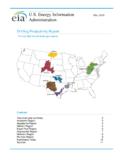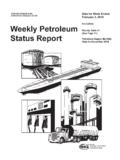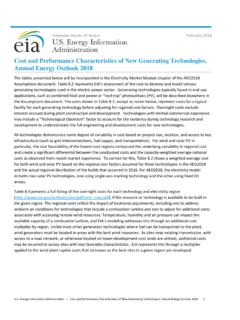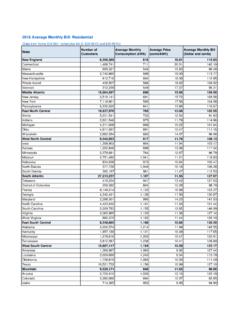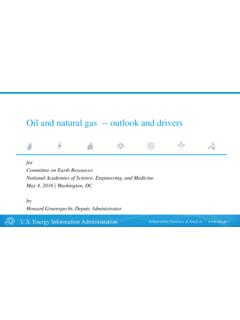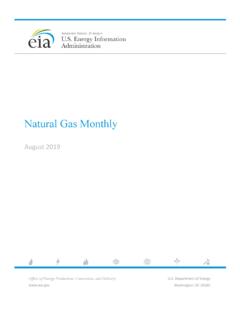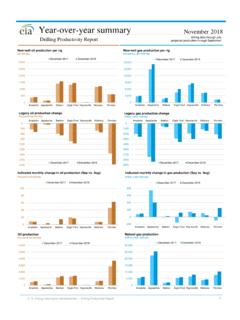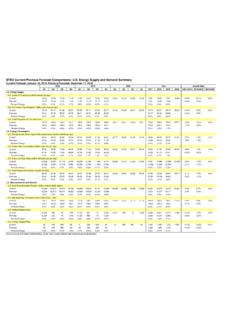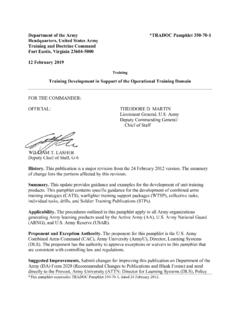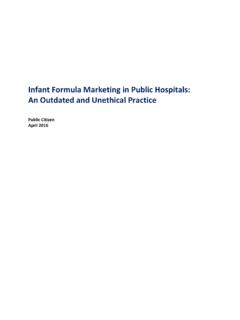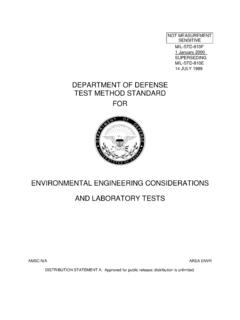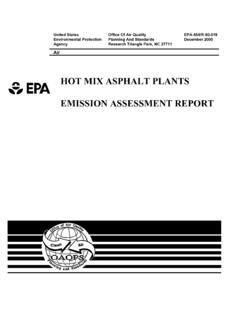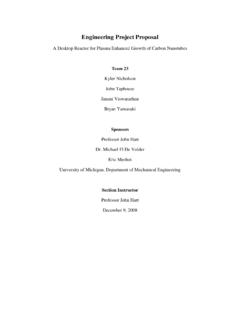Transcription of Technical Economic Analysis Guide - DRAFT
1 Technical Economic Analysis Guide - DRAFT July 2015 DRAFT for Review, Not Dissemination Independent Statistics & Analysis Department of Energy Washington, DC 20585 Energy Information Administration | Technical Economic Analysis Guide DRAFT for Review i This report was prepared by the Energy Information Administration (EIA), the statistical and analytical agency within the Department of Energy. By law, EIA s data, analyses, and forecasts are independent of approval by any other officer or employee of the United States Government. The views in this report therefore should not be construed as representing those of the Department of Energy or other federal for Review, Not for Dissemination July 2015 Energy Information Administration | Technical Economic Analysis Guide DRAFT for Review ii Table of Contents Table of Tables.
2 Iv Introduction .. 1 Assessing technology maturity .. 1 Defining Technical Economic Analysis .. 2 Reporting analytical results .. 2 Choosing a project cost estimating method .. 4 Estimating project capital costs .. 7 Overnight capital cost .. 7 Total project cost .. 8 International cost estimates .. 9 Estimating O&M costs .. 11 Feedstock costs .. 13 Non-feedstock costs: fixed O&M .. 14 Interest on debt, property taxes, and insurance .. 14 Maintenance and Repairs .. 14 Depreciation .. 14 Salvage, scrap, and land value .. 15 Non-feedstock costs: variable O&M costs .. 16 Operating labor .. 16 Utilities .. 16 Patent and royalties .. 17 Non-feedstock costs: plant overhead costs .. 17 Market demand and prices .. 18 Breakeven 18 Breakeven price of the key product .. 19 Comparative Analysis .. 21 Sensitivity Analysis .. 21 Market penetration Analysis .
3 22 appendix A. Glossary .. 23 appendix B. Initial assessment of technology .. 26 DRAFT for Review, Not for Dissemination July 2015 Energy Information Administration | Technical Economic Analysis Guide DRAFT for Review iii appendix C. Fundamental questions .. 28 appendix D. Capital cost breakdown .. 30 Fixed capital cost .. 31 Civil and structural costs .. 31 Mechanical equipment supply and installation .. 32 Piping .. 33 Electrical, instrumentation, and control .. 34 Project indirect costs .. 34 Owners Cost .. 35 Working capital .. 36 Health, Safety, and Environmental Costs .. 36 Cost of project financing and cost of capital .. 37 Salvage, scrap, and land value .. 37 Interest during construction (IDC) .. 38 Learning, Scaling and Optimism .. 38 Learning .. 38 Scaling .. 40 Optimism .. 41 appendix E. Reporting Analysis results.
4 42 appendix F. Top-down technology Analysis example .. 44 Order-of -magnitude estimate (top-down estimate) .. 44 Estimation of feedstock cost .. 45 Amortized capital cost .. 46 Estimation of O&M costs .. 46 Revenue .. 46 DRAFT for Review, Not for Dissemination July 2015 Energy Information Administration | Technical Economic Analysis Guide DRAFT for Review iv Table of Figures Figure 1. Project cost terminology .. 7 Figure 2. O&M cost 11 Figure 3. Breakeven curve example .. 20 Figure B-1. Initial technology assessment steps .. 26 Figure D-1. Working capital components .. 36 Figure D-2. Learning curves at various rates .. 40 Figure F- 1. Overnight capital cost estimate (top-down approach) .. 45 Figure F-2. Breakeven Analysis GTL example .. 47 Table of Tables Table 1. Liquid fuel technologies analyzed by EIA in its long-term outlooks.
5 1 Table 2. Estimating project costs by category and method .. 4 Table 3. Estimating capital costs using Lang factors .. 5 Table 4. Summary of O&M costs .. 12 Table 5. Depreciation estimation methods .. 15 Table 6. Sensitivity Analysis parameters .. 21 Table B-1. Technology readiness levels Table D-1. Typical cost-scaling indices for equipment cost as function of capacity .. 33 Table D-2. Estimated cost of piping .. 34 Table F-1. Comparative data of existing plants .. 44 DRAFT for Review, Not for Dissemination July 2015 Energy Information Administration | Technical Economic Analysis Guide DRAFT for Review 1 Introduction The mission of the Energy Information Administration (EIA) is to provide independent energy information to the public, the government and other energy stakeholders. This independent energy information includes the operating status of surveyed facilities, and both short-term and long-term projections.
6 The EIA Office of Energy Analysis (OEA) produces the Annual Energy Outlook (AEO) and International Energy Outlook (IEO), which include estimating deployment rates for a variety of technologies under a range of future market conditions. The better EIA understands how a technology may penetrate the market under different scenarios, the better EIA can model and project technology deployment over 30-year horizons. Conducting Technical Economic analyzes enables EIA to consistently represent energy technologies in its models and energy reports. The long-term projections include non-petroleum fuels that are not yet in common use as fuel-grade products for blending with traditional petroleum products, and alternative feedstock for the traditional petroleum refinery. The EIA/OEA Office of Petroleum, Natural Gas, and Biofuels Analysis (PNGBA) is responsible for analyzing these renewable and emerging liquid fuel technologies and developing reasonable Technical and Economic assumptions to inform the models that project the penetration of these technologies (Table 1).
7 Table 1. Liquid fuel technologies analyzed by EIA in its long-term outlooks Biochemical Thermochemical catalytic Thermochemical Fischer-Tropsch Corn ethanol Methyl ester biodiesel Gas-to-Liquids (GTL) Advanced grain ethanol Non-ester renewable diesel Coal-to-Liquids (CTL) Cellulosic ethanol Pyrolysis Biomass-to-Liquids (BTL) Biobutanol Source: Energy Information Administration, Office of Energy Analysis Assessing technology maturity EIA s objective in modeling technologies is to estimate the Technical , regulatory, and market conditions that induce successful deployment of a technology.
8 This includes modeling both emerging technologies and existing commercial technologies that currently lack a significant market presence. EIA focuses its Analysis on advanced technologies that have a Technology Readiness Level (TRL) of 7 or higher (see appendix A for glossary of all terms used in this report). TRL 7 technologies have been demonstrated in a relevant environment and the final design is virtually complete. The technology has overcome the two death valleys in the path towards commercialization. EIA also analyzes existing technologies that currently are deployed in limited quantities in either domestic or foreign markets. Technical Economic Analysis the detailed examination of plant and market conditions required for the investment in a technology with consideration of technology characteristics, plant project costs, plant operational costs and revenues, non- Economic factors, and plant location.
9 DRAFT for Review, Not for Dissemination July 2015 Energy Information Administration | Technical Economic Analysis Guide DRAFT for Review 2 Technologies are developed because they have at least one advantage over conventional technologies that needs to be quantified. The technology might be less expensive, perform more efficiently, or generate fewer pollutants, etc. Certain technology attributes and requirements may be mandated by regulation or be location-dependent. Technologies at TRL 7 and higher are best suited for Analysis because they have the required level of maturity and sufficient data to enable EIA to perform a Technical Economic Analysis (see appendix B for initial assessment of technologies). Technologies that are less mature are also analyzed by EIA to examine and model long-range energy scenarios where currently less mature technologies may deploy.
10 It is necessary to gather information about the market(s), including how both the market and the advanced technology are likely to evolve over time ( demand, competition, prices, learning, regulations, and taxes). Once the data needs are known, it s time to identify the data sources for both the technology and the markets. Defining Technical Economic Analysis In Technical Economic Analysis , multiple analyses are required: technology, project design, project capital costs, operation and maintenance (O&M) costs, and operational cash flows. These analyses are strongly interrelated and a variety of skills and tools are needed for each phase of the Analysis . A comprehensive Technical Economic Analysis of a technology is a team effort that includes experienced chemical engineers, project management and project finance professionals, and analysts.
